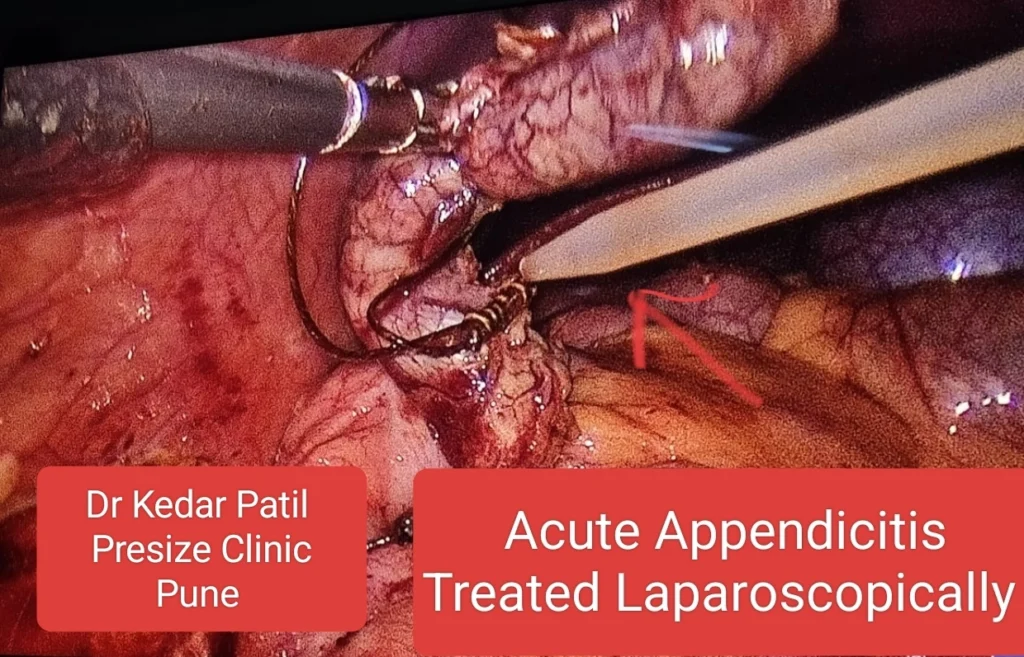
Presize Clinic
Call : +(91)-8888655455
Mail : presizeclinic@gmail.com
Address : Office No 303, Shivai 1, Sinhagad Road, Parvati Paytha, Landmark Nearby Sarasbaug and Dandekar Pul. Pune 411028, Maharashtra, India.
1000 +
Surgeries Done
Pain-Free Laparoscopic Appendectomy in Pune – Faster Recovery, Less Scarring
What is Laparoscopic Appendectomy?
Laparoscopic appendectomy is a minimally invasive surgery to remove an inflamed appendix using small incisions and a tiny camera (laparoscope). It is the preferred treatment for appendicitis, offering less pain, minimal scarring, and a quicker recovery compared to open surgery.
The procedure is safe, efficient, and typically allows patients to return to normal activities within a week. If you have symptoms like severe abdominal pain, nausea, or fever, timely surgery is crucial to prevent complications like rupture or infection.
When is Laparoscopic Appendectomy Needed?
Laparoscopic appendectomy is required when appendicitis occurs—an infection and inflammation of the appendix that can rapidly worsen. Recognizing the symptoms early is crucial to prevent complications like rupture, peritonitis, or abscess formation.
Signs You Need an Appendectomy:
- Abdominal Pain: Starts as a dull discomfort around the navel, then shifts to the lower right abdomen within 6-12 hours. The pain intensifies, becoming sharp and constant, worsening with movement, coughing, or deep breathing.
- Persistent Vomiting & Nausea: Vomiting more than twice within a few hours after pain starts may indicate appendicitis.
- Loss of Appetite: Sudden disinterest in food, often accompanied by nausea.
- Fever: Low-grade fever (99°F–100.5°F) in early stages; can spike above 101°F if the appendix ruptures.
- Bloating & Digestive Issues: Difficulty passing gas, constipation, or diarrhea may occur.
- Rebound Tenderness: Pressing on the lower right abdomen may cause pain that worsens when released.
If you experience sharp, persistent pain lasting over 6 hours, along with nausea, vomiting, or fever, seek emergency medical care—delaying treatment increases the risk of complications.
How Dr. Kedar Performs Laparoscopic Appendix Surgery in Pune?
Laparoscopic appendectomy is a minimally invasive procedure performed under general anesthesia, meaning the patient is unconscious and feels no pain during surgery. The procedure typically takes 30 to 60 minutes, depending on the severity of the appendicitis and the presence of complications like rupture or abscess formation.
Step-by-Step Procedure
Anaesthesia & Preparation:
- The patient is given general anaesthesia for a painless experience.
- The abdomen is sterilized, and a catheter may be placed to drain urine.
Creating Access Points:
- The surgeon makes 3 small incisions (each 5-10mm) in the abdomen, near the navel, lower abdomen, and left side.
- Carbon dioxide (CO₂) gas is pumped into the abdominal cavity to create space, allowing better visibility and movement of surgical instruments.
Inserting the Laparoscope & Instruments:
- A laparoscope is inserted through one incision, providing a magnified real-time video feed on a monitor.
- Specialized laparoscopic instruments are inserted through the other incisions.
Appendix Identification & Removal:
- The surgeon carefully locates the inflamed appendix and examines its condition.
- The appendix is isolated and clamped to prevent contamination.
- The appendiceal artery is sealed and cut to stop blood flow.
- The base of the appendix is tied with sutures or a surgical stapler and safely removed through one of the incisions.

Cleaning & Closure:
- If the appendix has ruptured, the area is thoroughly irrigated with sterile fluid to remove infection.
- The instruments and laparoscope are removed, and the incisions are closed using dissolvable sutures or skin glue.
Post-Surgical Care:
- The patient is monitored as they wake up from anesthesia.
- Pain management and antibiotics are administered.
- Most patients can go home within 24 hours, though hospital stay may be extended in case of complications like perforation or abscess.
What to Expect After Surgery?
- Mild abdominal pain and bloating from trapped CO₂ gas, resolving within 24-48 hours.
- Small steri-strips or bandages covering incisions, which heal within 1-2 weeks.
- Limited physical activity for 5-7 days, with a full return to normal activities in 2-4 weeks.
- Laparoscopic appendectomy ensures faster healing, minimal scarring, and reduced post-operative discomfort, making it the gold standard for appendicitis treatment.
Advantages of Laparoscopic Appendectomy
Laparoscopic appendectomy offers multiple benefits over open surgery, significantly improving patient comfort, recovery time, and overall experience. Here’s what it means for you:
Less Pain, Faster Recovery
- Since the procedure involves tiny incisions (5-10mm) instead of a large abdominal cut, there is minimal trauma to muscles and tissues.
- Patients experience 40-50% less post-operative pain compared to open surgery.
- Most patients can walk within a few hours and resume light activities in 3-5 days.
Minimal Scarring, Better Cosmetic Outcome
- Open appendectomy leaves a 6-8 cm scar, while laparoscopic surgery results in 3-4 tiny scars that fade significantly over time.
- This is especially beneficial for younger patients and those concerned about the aesthetic impact of surgery.
Lower Risk of Infection & Complications
- Small incisions mean reduced exposure to external bacteria, lowering the risk of wound infections and post-surgical complications.
- Studies show up to 50% lower rates of wound infection compared to open appendectomy.
Shorter Hospital Stay
- Most patients are discharged within 24 hours of surgery, compared to 2-3 days for open surgery.
- This means less disruption to daily life, lower medical costs, and faster return to normalcy.
Quicker Return to Work & Daily Activities
- Patients can return to desk jobs in about 5-7 days and physically demanding jobs in 2-4 weeks.
- Athletes and fitness enthusiasts can gradually resume workouts after 3-4 weeks with medical clearance.
Less Internal Scarring & Adhesions
- Open surgery increases the risk of internal scar tissue formation (adhesions), which can lead to complications like chronic pain and bowel obstruction.
- Laparoscopic surgery greatly reduces this risk, preserving long-term abdominal health.
Ideal for Overweight & High-Risk Patients
- Obese patients and those with conditions like diabetes or hypertension face higher risks of wound infection and slower healing with open surgery.
- Laparoscopic appendectomy is safer for high-risk patients, as it results in less bleeding, smaller wounds, and faster healing.
Bottom Line
Laparoscopic appendectomy isn’t just a modern alternative—it’s the preferred choice for faster recovery, less pain, and a safer surgical experience. If you or a loved one needs appendicitis surgery, opting for a minimally invasive approach ensures the best possible outcome.
Post-Surgery Recovery and Care
Recovering from a laparoscopic appendectomy is quick and smooth, but proper care is essential for optimal healing.
Recovery Timeline:
- Hospital Stay: Most patients go home within 24 hours.
- First Week: Mild soreness, bloating, and fatigue are common.
- Full Recovery: 1-2 weeks for normal activities, 3-4 weeks for strenuous work or exercise.
Do’s & Don’ts After Surgery:
✔ Rest & Hydrate: Drink plenty of fluids and eat a light, nutritious diet.
✔ Move Gently: Walking helps prevent blood clots and speeds recovery.
✔ Take Prescribed Medications: Pain relievers and antibiotics as advised.
✔ Watch for Warning Signs: High fever (>101°F), severe pain, or pus from wounds.
Avoid heavy lifting, smoking, and alcohol for at least 2-4 weeks.
Regular follow-ups with your surgeon ensure a smooth and complication-free recovery.
Why Choose Us for Laparoscopic Appendectomy Surgery in Pune?
✅ Expert Surgeons: Highly skilled in minimally invasive appendectomy with a track record of safe, successful surgeries.
✅ Faster Recovery: Small incisions mean less pain, minimal scarring, and quicker return to daily life.
✅ Advanced Technology: State-of-the-art laparoscopic equipment ensures precision and fewer complications.
✅ Personalized Care: Pre-surgery guidance, customized recovery plans, and 24/7 support for a smooth experience.
✅ Hassle-Free Process: Insurance assistance, minimal hospital stay, and dedicated post-op care.
Frequently Asked Questions (FAQs) About Laparoscopic Appendectomy
No, appendicitis does not resolve on its own and delaying surgery can lead to rupture, which is a medical emergency. Even if the pain subsides temporarily, the infection can worsen over time. Seek immediate medical attention.
Yes, laparoscopic appendectomy is safer for elderly patients compared to open surgery. It reduces blood loss, infection risks, and recovery time, making it the preferred option for high-risk individuals.
Most patients can start with clear liquids within a few hours post-surgery and gradually progress to a normal diet within 24-48 hours. Avoid greasy or heavy foods initially to prevent nausea.
No, the appendix has no critical digestive function. Most people experience no long-term digestive issues after surgery. Temporary bloating or mild discomfort is normal but resolves within a few days.
No, once the appendix is removed, appendicitis cannot recur. However, in rare cases, stump appendicitis can occur if a small portion of the appendix remains, but this is extremely uncommon.
Light activities like walking can start within 24 hours, but strenuous exercise, weight lifting, or core workouts should be avoided for 3-4 weeks to allow proper healing.
Yes, antibiotics are usually prescribed for a few days post-surgery to prevent infection, especially if the appendix was ruptured. Always complete the full course as directed by your doctor.

